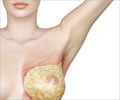
‘SG could provide better clinical benefit compared to irinotecan in patients with tumors expressing high levels of Trop-2, and among patients with HRR-deficient tumors expressing low/moderate levels of Trop-2.’
Read More..Tweet it Now
SG mediated >2-fold increase in Rad51 in MDA-MB-231 but had no effect in SK-MES-1 or HCC1806, resulting in lower levels of dsDNA breaks in MDA-MB-231. SG and saline produced similar effects in parental MDA-MB-231 tumor-bearing mice.Read More..
However, in mice bearing higher Trop-2-expressing C13 and C39 tumors after Trop-2 transfection, SG provided a significant survival benefit, even compared to irinotecan.
These results suggest that SG could provide better clinical benefit than irinotecan in patients with HRR-proficient tumors expressing high levels of Trop-2, as well as to patients with HRR-deficient tumors expressing low/moderate levels of Trop-2.
Dr. Thomas M. Cardillo from Immunomedics, Inc said, "In recent years, there has been an increased focus on personalized cancer therapy."
SG demonstrated significant clinical benefit across a range of solid tumors, including metastatic TNBC, hormone-positive breast cancer, small-cell lung cancer, non-small-cell lung cancer, and metastatic urothelial carcinomas.
Advertisement
Herein, the Oncotarget authors examined the HRR response in MDA-MB-231, being unresponsive to SG, including upregulation of Rad51 and levels of dsDNA breaks mediated by SG exposure, and compared it to that of SG-sensitive tumor lines to elucidate the role that this pathway plays in protecting cells from SG-mediated dsDNA breaks.
Advertisement
However, this does not rule out SG being active in tumors with low Trop-2 expression and deficiencies in HRR.
The Cardillo Research Team concluded in their Oncotarget Research Paper that, these data strongly support the hypothesis that as a biomarker, high surface Trop-2 expression on a patient's tumor may be predictive of a positive clinical outcome for SG therapy.
Further, there are secondary biomarkers that may need to be considered for those patients with low/moderate Trop-2 expression or those with high Trop-2 expression that failed previous irinotecan therapy for reasons other than acquired resistance.
Moreover, while high expression of Trop-2 was found to be a primary biomarker for SG efficacy, it should not be a limiting factor, because other secondary biomarkers coupled with Trop-2 expression may likewise be predictive of clinical benefit.
For these reasons, future clinical trials will need to comprehensively examine potential biomarkers, in addition to Trop-2 expression, to generate a profile that will better identify those patients likely to benefit from SG therapy.
Source-Eurekalert












